The use of a brick stove to heat a home has a very long and rich history. From the time when a person was able to make fire with his own hands, he equipped his dwelling on its basis, cooked food, protected himself from dangers, driving away wild animals. Over time, technology became more sophisticated, and a transformation began that changed the open fire heating system to using a stove.
There are several dozen variations that offer different functions and features. Ovens can only act as a hob, these are the most compact devices, it will not be difficult to lay them out with your own hands. Larger structures serve as heating means. But the greatest popularity has always been, and is still used in non-gasified regions, large ovens that heat the house, cook food for themselves or livestock, bake bread, dry fruits in them.
The modernization of such structures continues to this day. The fact is that earlier houses were built small, often for one or two rooms, with low ceilings. Such a layout of the house made it possible not to create an extensive heating system, the heat of the stove was enough to heat it entirely. But such a disadvantage as the concentration of warm air at the top of the room and directly next to the stove does not allow high-quality heating of modern housing. Realizing that this defect needs to be corrected, people came up with a system with water heating in a house, where a heat exchanger built into a brick oven acts as a boiler. It is able to heat the whole house with high quality, thanks to the circulation of hot water through pipes to the convectors.
The principle of operation of a furnace with a heat exchanger
In a closed system, water, after cooling down, enters the heat exchanger and heats up again. Such heating can be done by hand, especially if it is created anew. It is rather problematic to remake an already finished oven. The main difficulty lies in the fact that the heat exchanger must be built into the already created furnace structure, its dimensions must necessarily correspond to the dimensions in order to ensure the proper level of its heating.
Brick kilns are divided into two main groups:
- keeping warm;
- fast-cooling.
The first option assumes that the furnace is built in such a way that it is heated up for a long time. But at the same time, after a firebox once a day, it is able to maintain the temperature of the house for a long time and does not exclude the possibility of cooking food without a new firewood. Furnaces that cool down quickly have good thermal conductivity, they heat up quickly, release energy into the room, but require constant monitoring.
Cons of water heating
A heat exchanger in any stove built by an experienced stove-maker or by oneself reduces the time 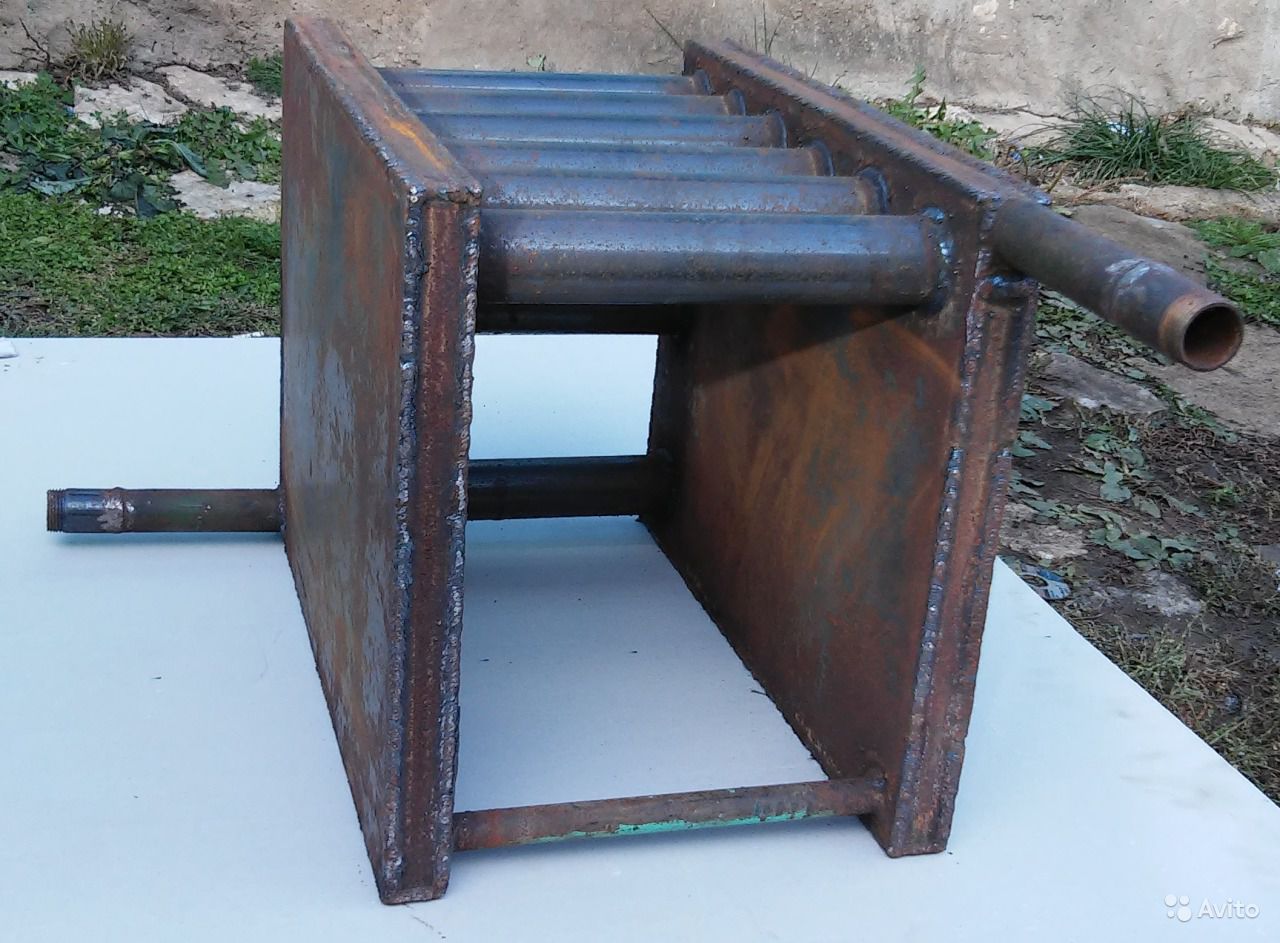 keep the oven warm. She needs to warm up not only her surface, but also the water from the system. This should be taken into account when building. It is especially important if the house is not used in winter, to choose the right fluid to fill the system. If it is decided to pour water into the heat exchanger and pipes, which is inherent in water heating systems, then in winter it can freeze, which will cause failure.
keep the oven warm. She needs to warm up not only her surface, but also the water from the system. This should be taken into account when building. It is especially important if the house is not used in winter, to choose the right fluid to fill the system. If it is decided to pour water into the heat exchanger and pipes, which is inherent in water heating systems, then in winter it can freeze, which will cause failure.
Professionals advise opting for special anti-freezing fluids.
Their cost will significantly affect the entire budget when creating a heating system, however, installation does not imply the use of very thick pipes, and the batteries available in every hardware store are no longer the ones that were used before. Their shape and volume of liquid required for the operation of the entire circuit are designed to minimize fuel consumption.
Types of registers, features and benefits
The heat exchanger can be of several configurations. Also, they are prefabricated or individually designed. In the first option, all technological nuances are provided, but the furnace must be created for a specific heat exchanger. If the heating system has already been created and needs to be completed, it will have to be created taking into account the existing furnace design. When you have skills in gas welding, you can try to make a heat exchanger with your own hands, otherwise, you should hire a specialist.
There are two main types of register structure applicable to water-based home heating systems. They can be made from tubes, in the form of a coil, through which the liquid circulates, or from steel plates. The tubular heat exchanger of a furnace equipped with water heating has a large heating area, which improves its characteristics. But a significant disadvantage is the possibility of water boiling during intensive heating. This can be avoided by using larger diameter pipes. Also, this problem can happen with water heating if the circulation of the liquid is insufficient. This happens due to improper installation of the system, installation of a heat exchanger with your own hands without proper experience and qualifications.
It is quite simple to fix the situation, it is enough to equip such a "boiler" pumping station, which will be liquid through the water tubes, preventing it from stagnating. Thus, the heat exchanger will not be able to heat it to a boiling state, and the batteries themselves will always be warm and all the rooms of the house will not cool down.
A tubular heat exchanger is used not only for stoves with water heating at home, but also in stoves, 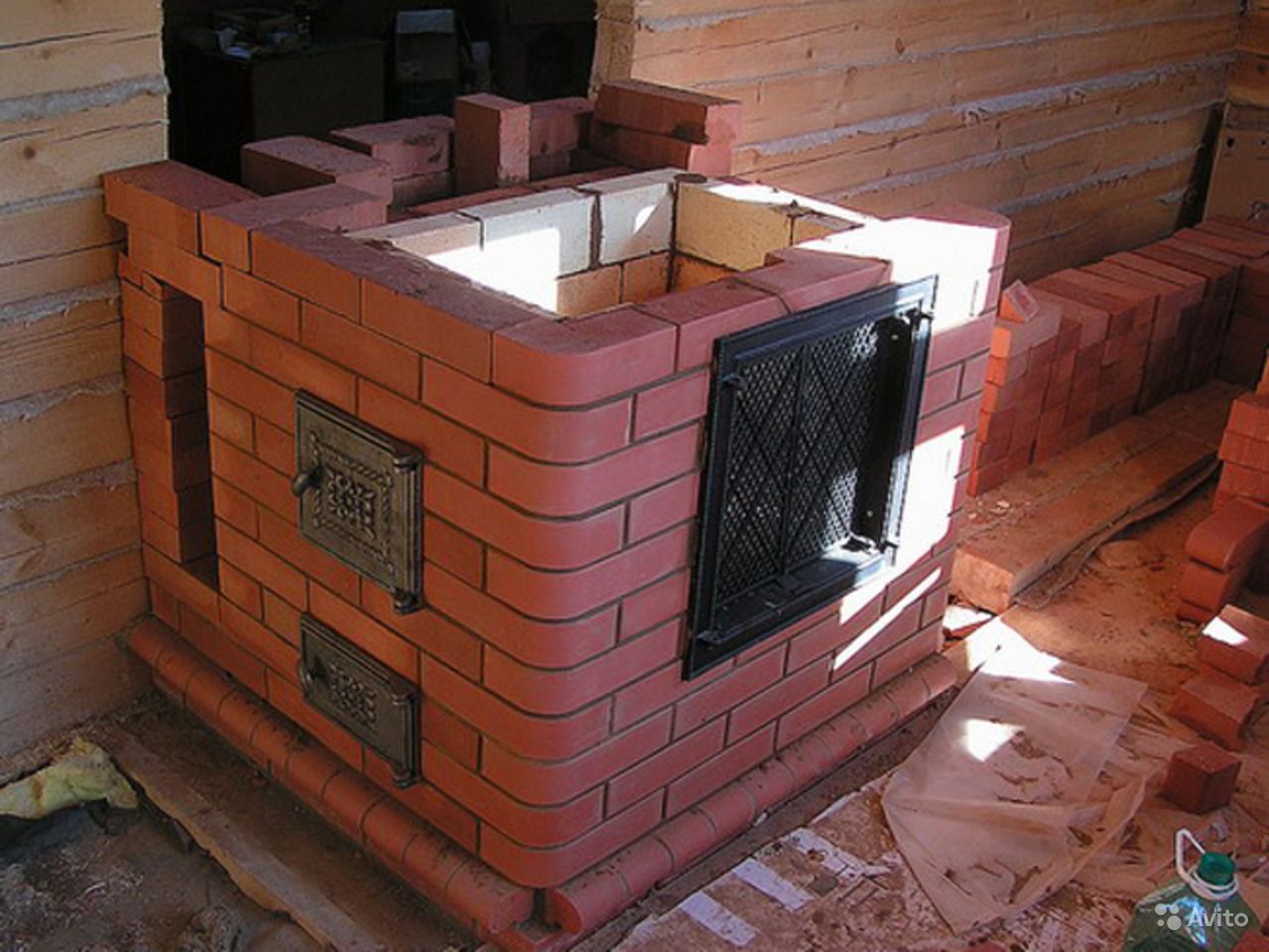 equipped with a stove. Its shape allows the register to be built into the oven so as not to reduce the quality of the hob heating. If there is no such need, then additional pipes are added to it. Such amplification will help increase efficiency. heating system.
The disadvantage of this form is the difficulty of cleaning. Soot, getting between the pipes, settles on them and impairs the permeability of heat, therefore, periodically it is necessary to monitor the water heat exchanger and clean it.
equipped with a stove. Its shape allows the register to be built into the oven so as not to reduce the quality of the hob heating. If there is no such need, then additional pipes are added to it. Such amplification will help increase efficiency. heating system.
The disadvantage of this form is the difficulty of cleaning. Soot, getting between the pipes, settles on them and impairs the permeability of heat, therefore, periodically it is necessary to monitor the water heat exchanger and clean it.
In a structure made of steel sheets, this problem is minimized. But it can only be used for heating stoves. In both cases, creating a register with a thickness of at least four centimeters will help to avoid boiling water in a system with water heating. If the upper shelf of the register is replaced with trumpet elements, it can also be adapted to the cooking oven.
Things to consider when building a furnace
Furnaces come in a variety of designs, but not all of them can accommodate a heat exchanger. For example, popular duct systems simply do not contain the space provided for the adaptation of the boiler. It is not difficult to create such a stove with your own hands, but it will not be able to perform all the functions that are expected of it.
Most a good option will become a chamber oven. The role of the chamber can be played by an oven, around which a heat exchanger is created. Thus, the design of the stove is also adapted for cooking, heating water and heating the house. Hot air from the register passes through the chamber, dousing it with the required thermal energy, and then passes into the convector, warming it up along its entire height. The convector is positioned along the entire height of the oven, complementing water heating, because he can calmly warm up the whole room.
By itself, building a brick oven with a heat exchanger is no different from a simple one. It is possible to build it with your own hands. Special material is required. It is customary to use a heat-resistant red brick as a solution; in places of the greatest temperature influence, it is replaced with chamotte. The mortar works best on a clay base.
Construction must begin with a foundation and waterproofing. A brick oven is a very heavy structure and needs solid foundation... Masonry requires precision and precision. Places where the brick will not be looped (furnace, crucible, door openings for ash disposal, etc.) need to be additionally reinforced and created with bandaging.
A stove built in accordance with all the rules will become an excellent basis for hot water heating, it will warm up the whole house with a minimum consumption of firewood and will last for many years.
There is a wide range of heat generators that differ in design and fuel types. If the building is located far from large settlements or is used intermittently, the best option will be the installation of a furnace heating system.
The heat exchanger for the stove, used in this design, will provide uniform heating of the entire house, as well as provide required amount hot water.
Application specificity
Standard stove heating implies an uneven distribution of heat energy - the farther from the source, the colder. After connecting the radiators and filling with water, the stoves act as analogues of solid fuel boilers, providing heating of the coolant, smoke channels and walls. Such a system during the firebox will allow heat to be transferred from the coil to the radiators, and after the fuel is extinguished, it will use the energy of the heated walls of the furnace.
When installing the heat exchanger, it should be borne in mind that its installation will reduce the useful volume of the fuel compartment and the fuel will have to be added much more often. Correct design of the water circuit and its relationship with the dimensions of the heating chamber will help to eliminate this problem. The device would be a good alternative.
Such an upgrade of the heating system has its own nuances. The energy that is released during the combustion of wood will heat the heat exchange unit and the working fluid placed in it, but the walls of the furnace will not change their temperature.
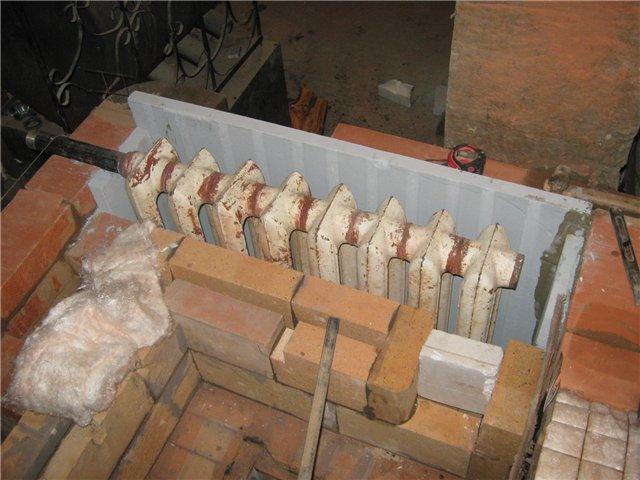
The upper part of the housing with smoke channels will undergo heating. If the building is used for temporary residence, the stove will be switched on irregularly and may freeze the liquid inside the pipes. In order to prevent accidents, it is recommended to replace the water with antifreeze.
Benefits
Installing a water circuit in the furnace heating system improves fuel efficiency.
The energy of the burnt coolant is spent on heating the body, smoke channels and walls, and also provides a high temperature of the water circulating through the pipes.
For property owners, this method provides additional benefits:

- ease of manufacture (they are often mounted in residential buildings, and for high-quality distribution of energy, it is enough to make a homemade heat exchanger by connecting it to the heating system of the building);
- combined heating due to warm air from the oven and hot water from the batteries;
- a variety of types of fuel (most boilers for heating use only one type of energy carrier, which can be expensive and ineffective, and the heat exchanger of a brick oven works at the expense of any solid fuel);
- pleasant appearance (design country house often occurs in the national style, but the installation of heat exchange units does not violate the traditional look of the Russian stove).
Design features
If the owner of the building has experience in bricklaying or oven works, installation can be done by hand. Before connecting a water heating system, you will also need to make a heat exchange unit.
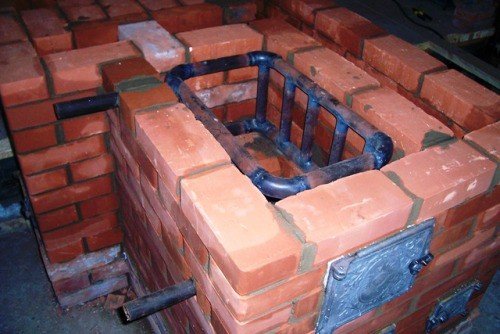
Despite the fact that the construction market offers a large selection of ready-made structures, self-production is more profitable. A hand-made installation allows you to take into account all the parameters of this particular furnace, its location and the dimensions of the fuel compartment.
Heat exchanger made of pipes
The device of a furnace heating system with a water circuit implies the installation of a heat exchanger in the fuel compartment of the furnace and the connection of pipes to it for supplying the working fluid. Coils welded from pipes and placed in metal containers are well suited for heating and cooking stoves and kitchen stoves. Their manufacture requires professionalism, and cleaning from combustion products is rather laborious, but the winding surface will provide rapid heating.
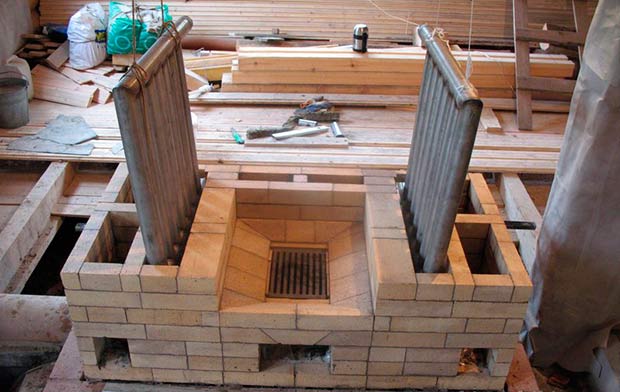
The 50 mm U-shaped pipes used in the construction can be replaced by segments shaped pipes 40x60 mm. This will simplify the welding work and greatly facilitate the installation. If the oven is not used for cooking, additional small diameter tubes are welded to the top of the heat exchange unit. A self-improved design will give off much more heat.
Devices of this type are used in ovens designed exclusively for heating a room. For their manufacture, you will need sheet metal half a centimeter thick, segments rectangular pipes 40x60 mm, as well as round tubes of the same diameter for supplying water to the working surface. The dimensions of the heat exchangers depend on the dimensions of the furnace compartments for fuel.
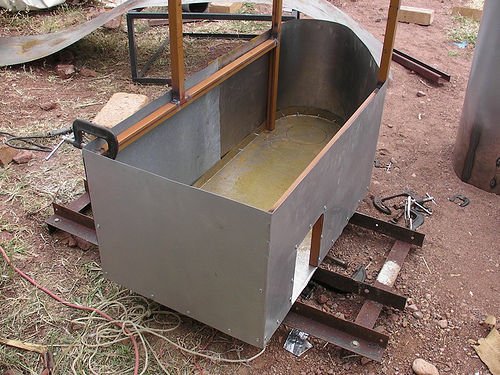
A similar heating system can be used for a heating and cooking stove or a simple kitchen stove. To do this, the structure must be mounted so that the heated gases from the fuel chamber move towards the upper shelf of the register, flow around it and enter the smoke channels.
An alternative option would be to manufacture a heat exchanger without an upper shelf, the sides of which will be connected to round or rectangular pipes.
Heating device installation
Heat exchangers for brick ovens can be made by hand from metal with a thickness of 2.5 mm. The structure will be based on two containers - a cylindrical upper and a rectangular lower, connected by pipes. The mating of the seams should take place with a minimum gap, and the diameter of the pipes should be calculated based on the dimensions of the furnace and the area of \u200b\u200bthe heated room. After checking the accuracy of the calculations and re-measuring the blanks, the parts are connected by welding.
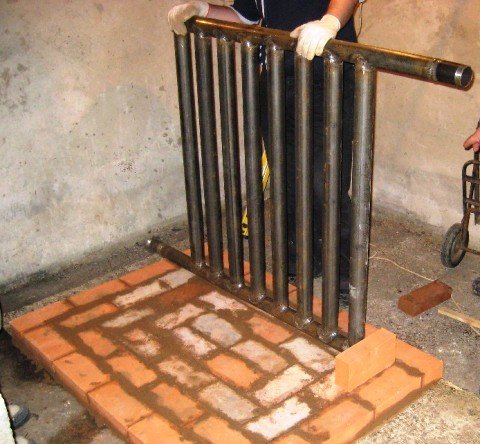
The strength of the finished structure is determined after welding the lower pipe, pouring water and connecting the outlet openings to the radiator tanks. When the installation is complete, it is necessary to fill the system with compressed air, monitoring the pressure with a pressure gauge. Well-welded seams will not leak. If leaks or other defects are found, the water is drained and the problem areas are sealed. An important parameter during installation will be the total length of the pipes - the smaller it is, the better the room will be heated.
The nuances of installation and operation
When installing heating units and putting them into operation, it is necessary to follow the installation technology and avoid emergency situations. The high temperature in the heating chamber makes high demands on the quality of the metal, the rationality of the heat exchange unit and the quality of welding. Knowledge of several simple rules will help ensure long-term and reliable operation of the furnace heating system.
The supporting circuits of the heat exchangers must not be fixed to the walls with fixed joints. The temperature to which pipes are heated causes expansion of the metal, which can lead to a change in their dimensions.
Copper will be a good material for stove heating pipes. The use of this metal will provide high thermal conductivity of the structure and ease of manufacture of the coil due to its plasticity.
The piping must be at least an inch. At lower values, the circuit will become inertial, and the fluid flow in it will seriously slow down. An increase in heat loss in heating lines will lead to a decrease in the efficiency - it will become colder in the room with the same fuel consumption.
The main element of any of the heating systems is a special device, in which heat is transferred from the heat generator to the coolant. A large number of different heating boilers are presented on the modern market, but all their variety does not limit the imagination of home craftsmen in terms of independent production of such devices. In our article, readers will be asked to find out why a heat exchanger is needed in the heating system, how to make it yourself and how to connect it.
Heat exchanger function in the heating system
In domestic air heating systems, surface heat exchangers of the heating system are most often used, where heat energy is transferred through the surfaces of the metal walls of the device.
The principle of heating through a heat exchanger is most fully implemented in the design of gas, solid fuel or electric boilers. The water circulates through coil-shaped pipes installed inside the heating unit and is heated by the temperature of the burning fuel. The heated coolant goes into the pipeline of the heating system, and cooled water from the radiators enters the heat exchanger to replace it.
Until now, in many individual houses, the stove remains the traditional source of heat. It is good for heating a small hut, however, in a multi-room cottage, it thermal power insufficient. Therefore, in a private house, a heat exchanger in the heating system is needed in order to turn the stove into a full-fledged water heating boiler. The size and shape of a home-made heat exchanger for heating should fit into the dimensions of the fuel chamber of the furnace. Pipelines and radiators can be connected to this device, and then the heating of the house will become more efficient.
Types of heat exchangers
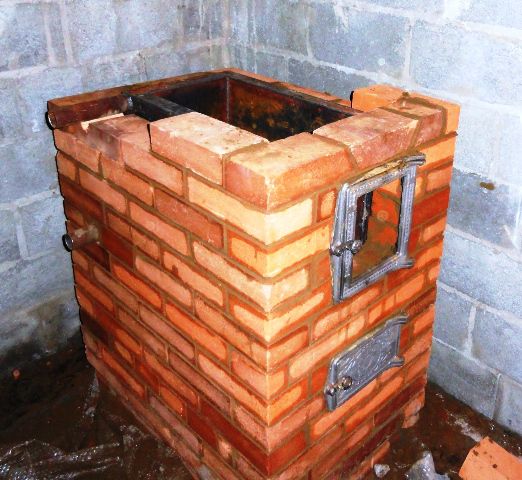
Water heat exchangers for heating are more practical. This is due to the fact that water transfers heat energy much better than air. However, the air heat exchanger for heating is also used. In addition to water and air, a heat exchanger is also used for the chimney for heating, which is installed not inside, but outside.
All industrial heating devices are equipped with heat exchangers, the design of which is maximally adapted for efficient water heating.
At the factory, heat exchangers are made of copper. The pipe is a coil, across the bends of which there are many plates, which provide a large heat exchange area.
It is almost impossible to build a homemade heat exchanger for heating at home so that it is exactly like a factory one. Therefore, you will have to choose an easier option.
System design
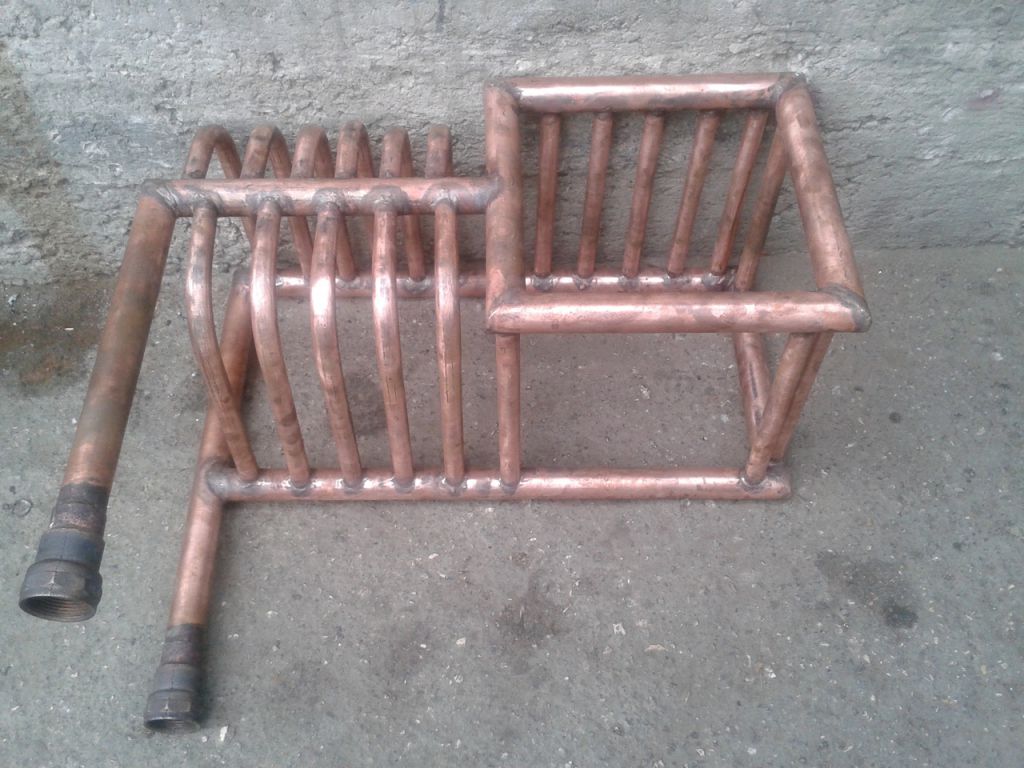
The principle of operation of a home-made heat exchanger is that the stove transfers energy to it from the combustion of wood or coal, and the heated water disperses through pipes to all rooms. This heating method allows the inhabitants of the house to enjoy an even distribution of heat. In addition, all rooms warm up much faster, and fuel costs are reduced.
There are two ways to improve stove heating of a private house:
- build a furnace "from scratch" for a specific size of the heat exchanger;
- install a home-made heat exchanger made to fit the size of the firebox into the existing furnace.
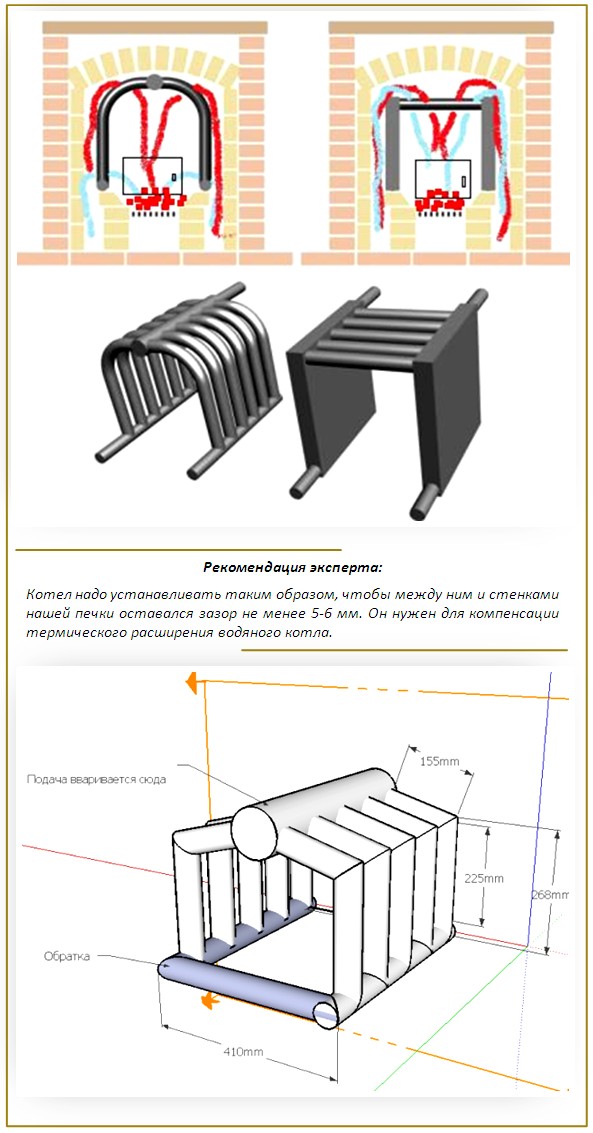
By making a heat exchanger for heating with their own hands, the homeowner can be sure that his stove with a water circuit will work no worse than a real solid fuel boiler. The only difference is that in the stove, the location of the inlet of the heat exchanger will turn out to be slightly higher above the floor than in factory boilers. This is a rather significant difference that can affect the rate of natural circulation of the coolant.
The connection of the heat exchanger to the heating system must be done in such a way that the cold water supply pipe (return) is located as low as possible.
Just like in a conventional heating system, an expansion tank must be installed at the top of the pipelines. It will compensate for the change in the volume of heated water and release air bubbles from the system. If heating through a natural circulation heat exchanger is insufficient to heat a large cottage, you will have to install a circulation pump in the system.
To connect a homemade heat exchanger for heating, 2 fittings are used: one from the bottom (cold water inlet), the other from above (hot outlet). When installing the heat exchanger, it is necessary to ensure the necessary slope of the pipes, as required by the scheme.
Advantages of heating with a heat exchanger

If you understand why you need a heat exchanger in a heating system, you can see several clear advantages:
- Ease of manufacture . If a stove already exists in the house, then you will only have to spend money on making a homemade heat exchanger and installing a heating system.
- ... In addition to heating the house from the surface of the stove, it will add water system heating.
- Variety of fuels. You can heat the stove with any solid energy sources, in contrast to boilers that are focused only on a certain type of fuel.
- Nice appearance. It is useful to preserve the traditional look of the Russian stove when creating an interior in the national style.
Among the disadvantages of heating through a heat exchanger are: less high efficiency compared to factory boilers and the lack of automatic control over the intensity of heating the coolant.
How to make a homemade heat exchanger
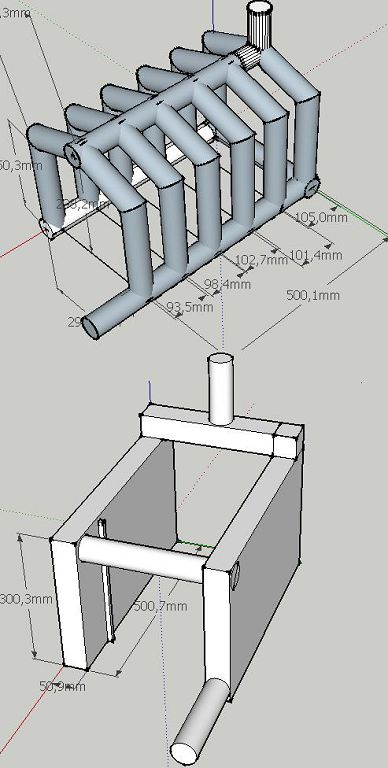
The shape of a heat exchanger for DIY heating can be different. The most common option is a register of several steel or copper pipes, but plate-type samples are also used.
The temperature in the combustion zone is very high, especially when coal is burning. Therefore, increased requirements are imposed on the metal from which the elements of the heat exchanger will be made, the rationality of its design and the quality of welds.
Materials for making
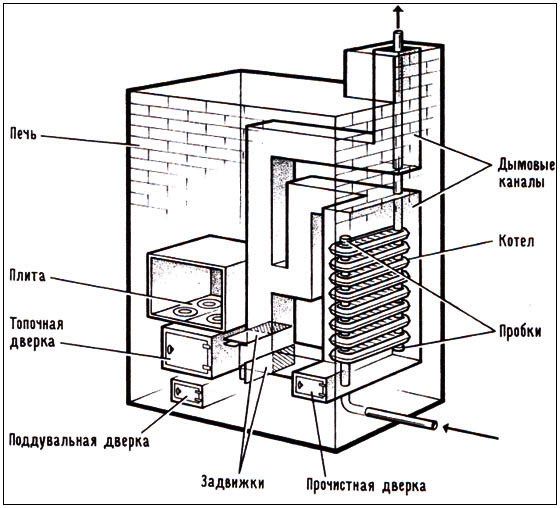
The task of water heat exchangers for heating is to ensure optimal heat transfer, and in this process the degree of thermal conductivity of the metal is important. For example, a steel pipe conducts heat 7 times less than a copper one. Therefore, with the same pipe diameter, 25 meters of steel pipe will be needed to transfer the same amount of heat instead of 3.5 meters of copper.
Copper heat exchangers are the most economical to operate, but also expensive. Heat exchangers made of a steel pipe with a diameter of at least 32 mm are considered more accessible for self-production.
If it is supposed to heat the stove with coal, it is better to install a cast iron heat exchanger. This metal is stronger, and the walls of the device will not burn out for a long time.
Heat exchanger power calculation
It is rather difficult to calculate in advance the capacity of a heat exchanger for a heating system. To do this, you need to take into account too many factors: pipe diameter, coil length, metal thermal conductivity, fuel combustion temperature, coolant circulation rate, etc. The real ability of the heat exchanger to cope with its functions will become clear only after the heating system starts operating.
When calculating, it can be guided that 1 meter of a pipe with a diameter of 50 mm, which serves as a heat exchanger, will give 1 kW of thermal power.
You can take, for example, any well-known boiler model and, in accordance with its parameters, make your own homemade heat exchanger.
Design features
A heat exchanger for water heating of a house, welded from smooth-walled pipes, is called a register. It looks like a kind of "grill" and is the most popular form of homemade heat exchanger. In addition to this design, simpler devices are made in the form of a rectangular or cylindrical tank. The main thing is that the surface area for heat exchange is as large as possible.
When making a heat exchanger with your own hands, several conditions must be observed:
- the width of the internal voids in the heat exchanger must be at least 5 mm, otherwise the water in it may boil;
- the wall thickness of the pipes must be at least 3 mm so that the metal does not burn out;
- a gap of 10–15 mm between the heat exchanger and the walls of the furnace must compensate for the expansion of the metal during heating.
Installation features
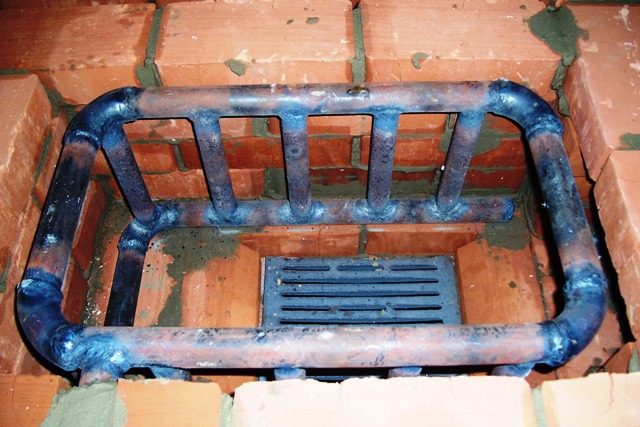
The easiest way is to install the heat exchanger simultaneously with the construction of the furnace. If you install it in an old oven, you will have to disassemble part of its brickwork.
Procedure:
- A tubular heat exchanger is installed on the prepared foundation of the furnace directly into the furnace cavity.
- With the further laying of the rows of bricks, space is left for the inlet and outlet pipes of the device.
- After completing the laying of the furnace, the heat exchanger is connected to the heating system, the system is filled with water and a test furnace is fired.
The video material invites you to familiarize yourself with useful tips for making a heat exchanger yourself:
Until now, we have only talked about heat exchangers in a hot water heating system. Let's pay attention to other areas of their application.
Air heating
If we characterize the air heating system, we can say that it has more disadvantages than advantages. Air heat exchangers for heating are not widely used in the private residential sector, they have not yet become familiar.
The advantage of this system is called the ability to combine heating with forced ventilation. However, possible errors in its design and installation can minimize the benefits. Fan noise can be heard in air ducts, and temperature imbalance is felt in rooms.
Heat exchangers for air heating exist for direct heating as well as indirect. In the first of these, gas or diesel fuel is burned directly in the heat exchanger itself. Other models use an intermediate heating medium.
Chimney heat exchanger
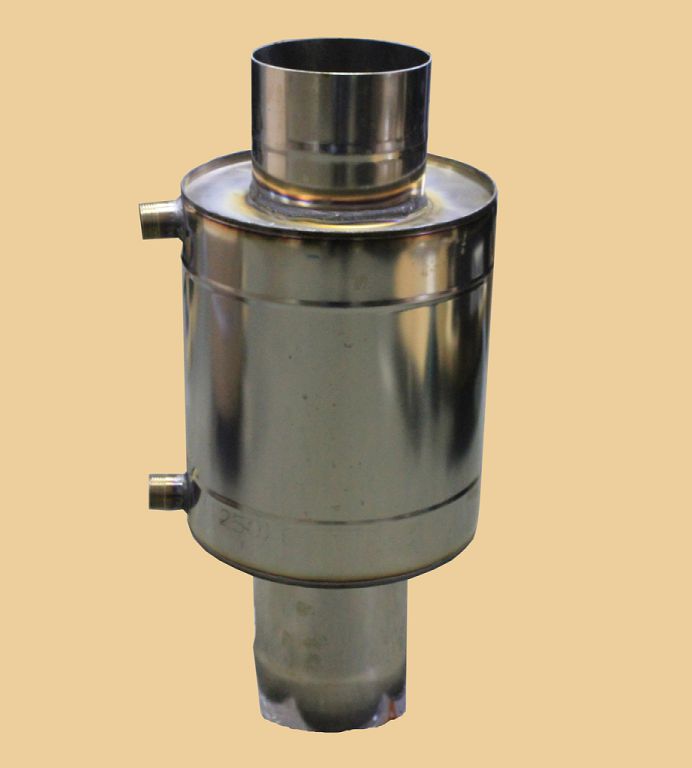
In the dachas and in the baths of the "folk craftsmen" you can see a homemade water or air heat exchanger installed on the chimney of a small stove. It turns out very profitable: the heat does not go away with the smoke, and part of it is used to heat the water.
By installing a heat exchanger on the chimney for heating, you can get a fairly large amount of hot water. Of course, this is not enough to heat the whole house, but it is enough to put one or two radiators in the dressing room. A chimney heat exchanger can be used both for heating and for quickly heating water in a bath.
Such a device can be very simple to manufacture. As a basis, you can take a piece of a large pipe with a diameter of 500-700 mm, or weld a stainless steel tank. In the center of the structure, there will be a vertical pipe corresponding to the diameter of the chimney, and two nozzles must be welded on top and bottom.
By giving its temperature to the heat exchanger, the combustion products leaving the furnace cool down quickly. Because of this, the draft in the chimney decreases and the combustion of fuel slows down somewhat.
Making a heat exchanger for heating with your own hands can be a way to arrange a full-fledged water heating in a house without purchasing expensive equipment.
Heat exchangers, coils - these terms are incomprehensible to most of us. Radiators, dryers and batteries are another matter, because we come across them every day. By the way, these are also heat exchangers, or rather, some of the types.
This article will focus on how to make a heat exchanger yourself.
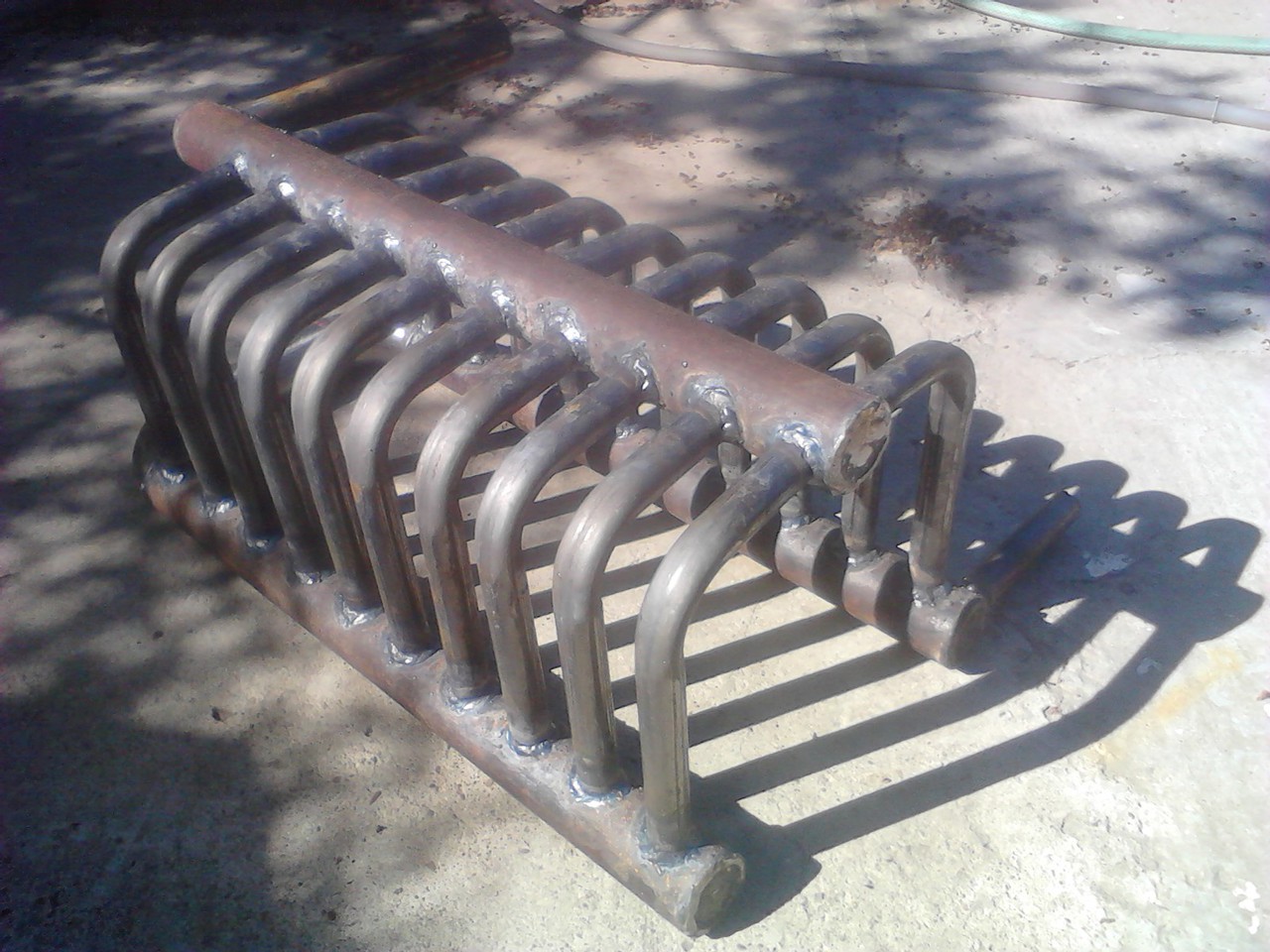
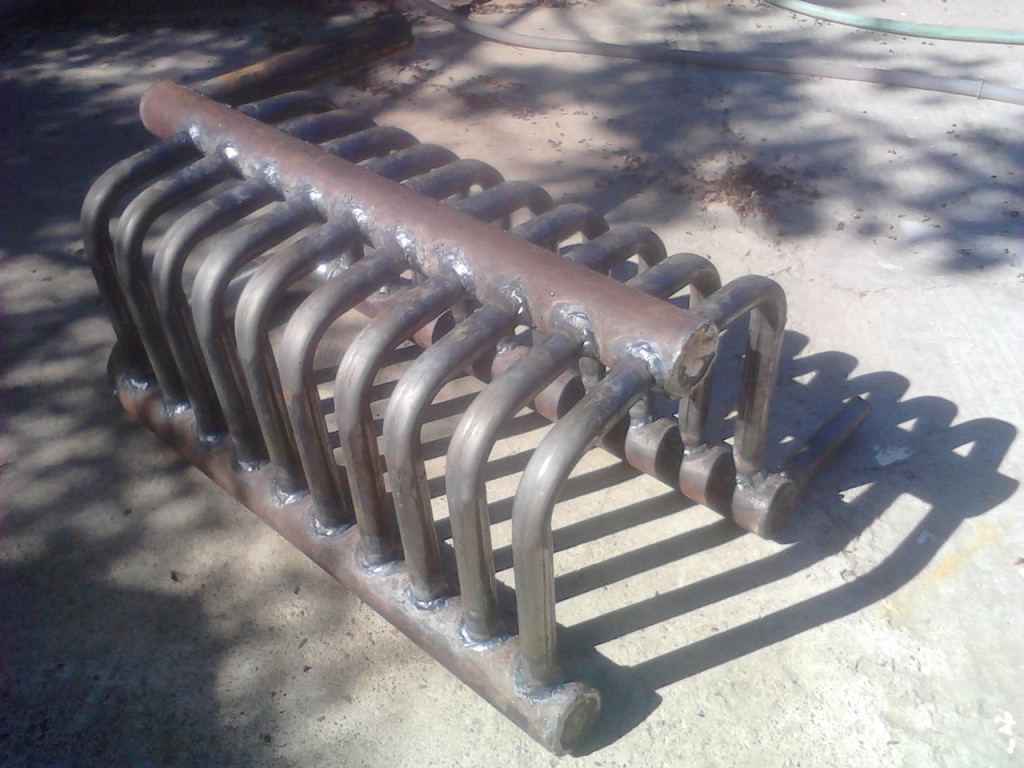
Features of heat exchangers
The creation of a heat exchanger is hardly possible without a preliminary study of the features and principle of operation of this device. In general, a heat exchanger is a device for the exchange of thermal energy between two media that do not have their own energy source. A stove, for example, is not a heat exchanger, while a couch that passes flue gas through itself and heats the air in the room with it.
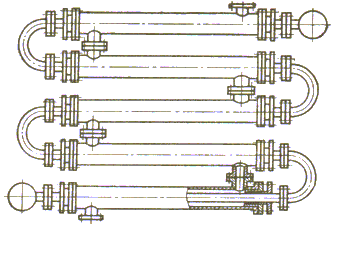

Another, more primitive type of heat exchanger can be considered the process of cooling a bottle under the pressure of cold tap water. In this case, the water heats up and the liquid inside the bottle is cooled.
What determines the efficiency of the heat exchanger
- First of all, the efficiency of this device is affected by the difference in temperature between the two media - the greater it is, the big amount energy they exchange.
- Another equally important factor is the thermal conductivity of the material.
- Finally, the heat transfer area is directly proportional to the efficiency of the device.
Important! Any pipeline through which a liquid circulates with a temperature different from the air temperature is considered a heat exchanger.
What are heat exchangers made of
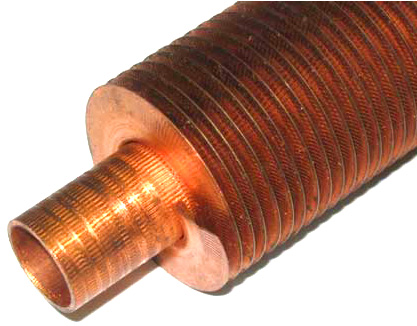

There are a great many designs of this device today. Every folk craftsman who was engaged in the manufacture of a heat exchanger tried to introduce something of his own, somehow improve it. Therefore, it is impossible to consider all the options. Meanwhile, the most popular components are given below:
- collectors;
- radiators from cars;
- registers;
- heating radiators;
- metal containers;
- coils.
Manufacturing technology
The simplest device of this type can be considered a copper pipe several meters long, rolled up in rings and installed in a barrel of water in such a way that only the entrance and exit remain outside. This design (called a "coil") is capable of cooling or heating the liquid in the barrel, depending on what is needed (in most cases, heating is required).
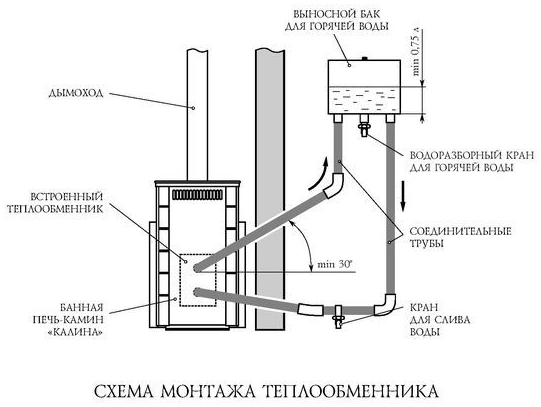

The "coil" cuts into the pipeline next to the furnace or into the storage tank. The spiral tube is installed at a height of 1.5-2 m and becomes an additional source of heat.
Important! If the stove is used not only for heating, but also for hot water supply, then the heat exchanger should not take more than a tenth of the heat generated by it.
![]()
![]()
Separately, it is worth talking about how long the pipe will be equal to, for example, 2 kilowatts. The main criterion in this case is the thermal conductivity of the material. Let's say the pipe diameter is 2 cm, and the temperature difference is 40 ° C. If you make simple calculations, it turns out that:
- metal-plastic pipes with their coefficient of thermal conductivity of 0.3 will require more than 4 km;
- steel pipes with an indicator of 50 - 25 m;
- copper pipes with a thermal conductivity of over 380 - only 3 m.
After such arithmetic problems, it is quite obvious that the most suitable material is copper. Moreover, this metal is easily bent and connected with a threaded fitting.


The most suitable option for a boiler or stove. For its manufacture, a metal tank of twenty liters and two copper tubes will be required.
Step one. If there is no suitable tank, then sheet steel with a thickness of 2.5 mm is taken and a tank of the required volume is welded from it. Welding should be carried out with a minimum seam thickness.
Step two. The tank is installed at a height of 1 m from the floor, but no further than 3 m from the heating stove. Two holes are made in it: one on the right, near the bottom of the structure, the second on the left, at the highest point.
Step three. The lower outlet is led to the furnace with a minimum downward slope of 2ᵒ. In this case, the upper branch is connected with a slope of 20ᵒ, but in the other direction.
Step four. At the outlet of the lower outlet, the drain cock of the storage tank is cut. At the lowest point of the same outlet, another tap is cut in to drain the entire system.
Step five. At the end of the installation, the heat exchanger is checked for leaks. For verification purposes, it is filled with water under a slight pressure - this will allow detecting leaks, if any.
Tube board
A heat exchanger with such an intricate name can also be made by hand, although this will require an experienced welder or skills in working with a welding machine.
For manufacturing you will need:
- sealed metal tanks, 2 pcs .;
- small diameter copper tubes, 15-20 pcs.
The reservoirs are located at the edges and are interconnected by copper pipes installed at an angle at different points of the containers. Water will move from one reservoir to another, and between them, in the place where the connecting pipes pass, and heat will be exchanged.
Important! This scheme formed the basis for heating multi-storey buildings.
Water jacket
An equally popular type of heat exchanger is the so-called water jacket. It consists of two sealed tanks of different diameters, one of which is placed in the other. But we note right away that such a structure is quite difficult to manufacture, and it is impossible to cope with it on your own without having special skills.
What else can be used
If for one reason or another it did not work to find a copper pipe, then you can try to find something suitable in the "home" scrap metal dump (every owner should have it). For example, the coil can be replaced with an old heated towel rail, you can also use cast iron batteries, having previously checked them for leaks.
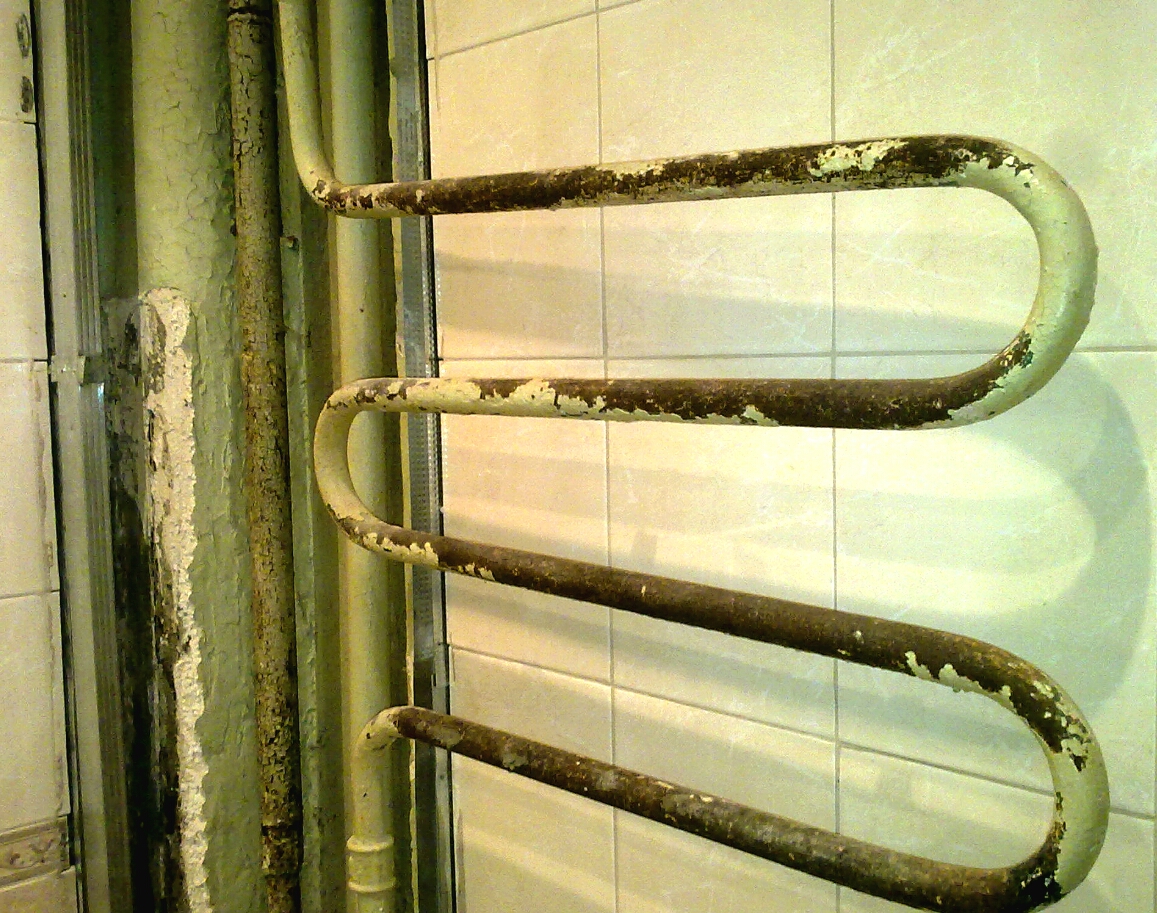
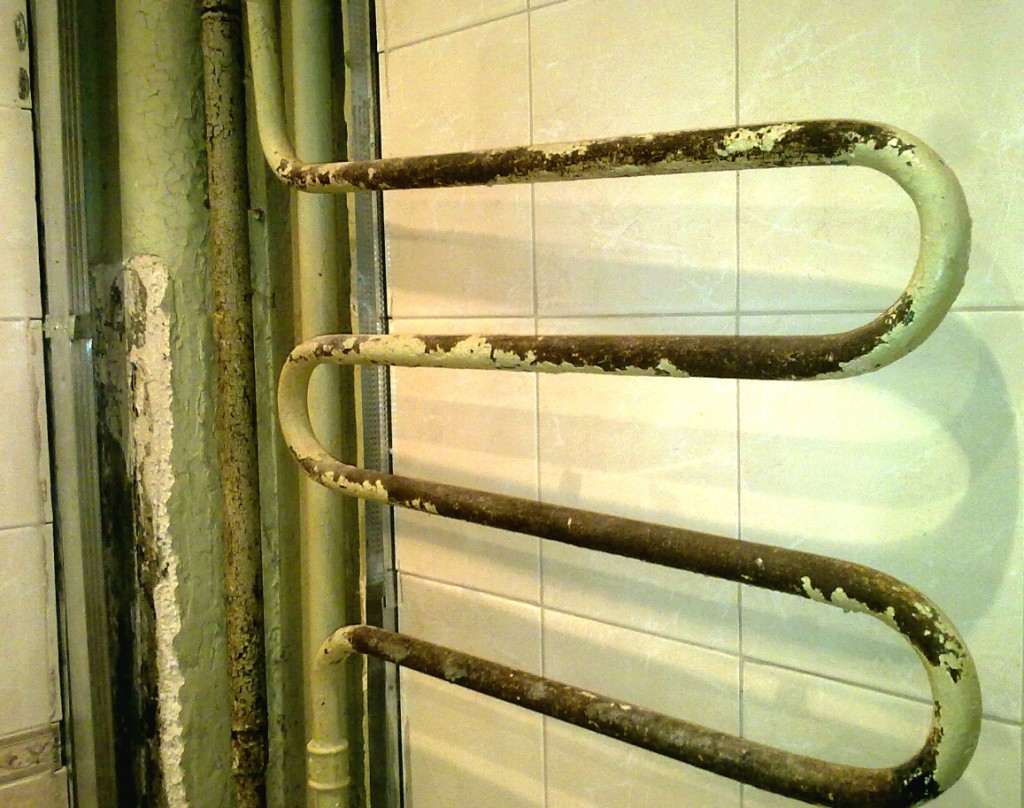
Radiators from automobile stoves can be considered ready-made heat exchangers. They can be used as heating elements, having previously thought out the adapters and, if necessary, connecting several radiators to increase the total heat exchange area.
Old gas water heaters are also great. Moreover, in this case, you don't even have to redo anything.
Features of operation
There are a number of requirements that must be adhered to when using this device so that it lasts as long as possible, without causing absolutely any harm.
- It is undesirable to fix the heat exchanger pipes (if any) on the walls of the room with fixed fasteners due to high temperature and, as a consequence, the expansion of the metal.
- If it is necessary to seal the pipe connection to the heat exchanger, then only material that can withstand high temperatures can be used.
- Do not pour water into an already heated brick oven with a heat exchanger.
- If the productivity of the furnace is low, then it is undesirable to install an overall heat exchanger on it, since it will take too much energy from it.
This option is suitable for those who plan to heat several rooms, but at the same time love a live fire.
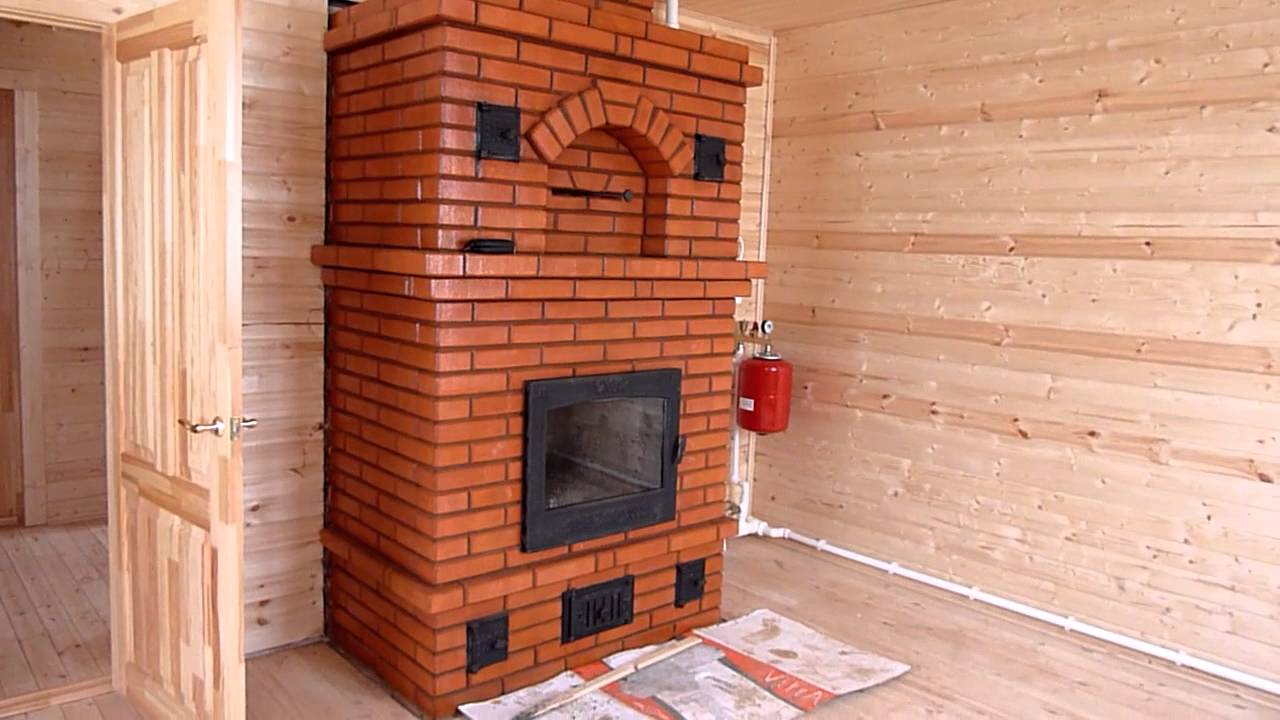
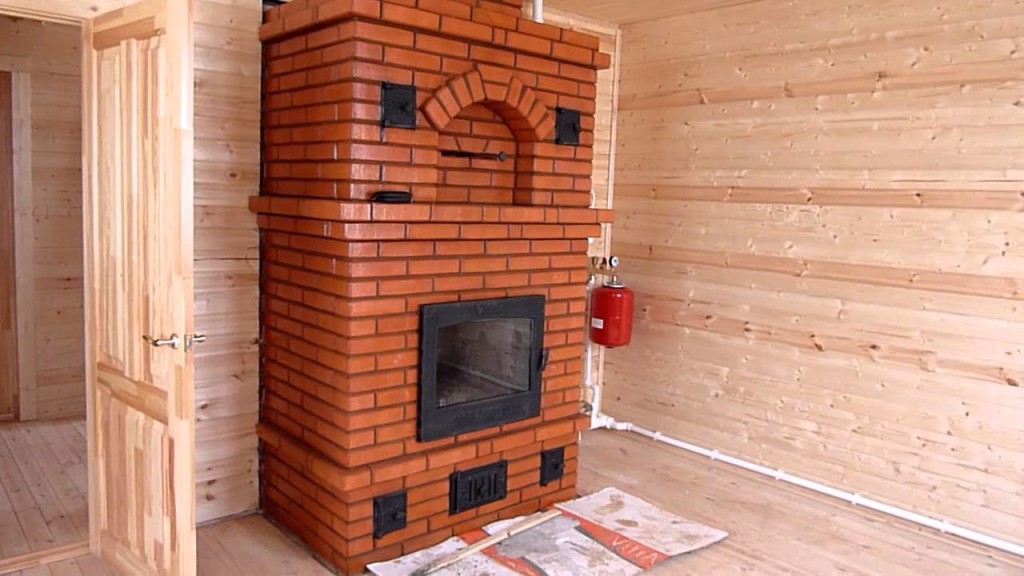
Design
The main element of such a system is a fireplace stove, from which numerous pipes, filled with a coolant (often water), run in all directions.
The liquid can circulate both naturally and forcibly - using special pumps. In other words, the furnace heats up the coolant, and pumps carry it across the entire heated area.


The installation of a heat exchanger can significantly increase the efficiency of the heat generator, and instead of one room, as in the previous versions, you can heat two at once without any special costs.
Main types
The modern market offers a lot of different fireplace stoves, and all of them can be equipped with a heat exchanger if you need to heat a large area. At the same time, someone pays attention to the type of fuel used, someone to power. The most popular options are discussed below.
The device on pellets, as the name suggests, differs in that instead of wood, it is fueled with pellets - an environmentally friendly fuel that is produced by pressing waste from the woodworking industry and is supplied in the form of pellets.


The main reason for the popularity of this type of fuel is its low cost. Moreover, when burning, it practically does not emit soot, so it is generally accepted that the future belongs to it.
Are no less popular cooking ovens, and the reason for this is polyfunctionality. With their help, you can not only heat the room, but also cook food. Original, practical and probably even romantic (I mean cooking over the fireplace).
conclusions
Now, after reading the article, you should understand what a furnace heat exchanger is and what its purpose is, as well as how to make its simplest versions yourself. This is not as difficult as it seems at first glance, you just need to decide on the type of heat exchanger and choose the best option for the heating system.
Video - Fireplace stove with heat exchanger. Diy oven heat exchanger
You can make a coil with your own hands from round or shaped pipes. This or that material is selected for different operating conditions. Such products are used to transfer heat in water heating systems. They can even be built into fireplaces or stoves, which allows them to be used as a boiler room to heat all the rooms of the house.
Types of coil heat exchangers
A heated towel rail is also a coil heat exchanger.
You can make a coil with your own hands of different designs and from several types of metal (steel, copper, aluminum, cast iron). Aluminum and cast iron products are stamped in factories, since the required conditions for working with these metals can only be achieved in production conditions. Without this, it will only work with steel or copper. It is best to use copper as it is malleable and has a high degree of thermal conductivity. There are two schemes for making a coil:
- screw;
- parallel.
The helical scheme implies the location of the spiral turns along a helical line. The coolant in such heat exchangers moves in one direction. If necessary, to increase the heat output, several spirals can be combined according to the "pipe in pipe" principle.
To minimize heat loss, you need to choose. It also depends on the material of the walls.
It should be done based on the vapor permeability of the thermal insulation.
In a parallel circuit, the coolant constantly changes its direction of movement. Such a heat exchanger is made of straight pipes connected by a 180 degree elbow. In some cases, for example, for the manufacture of a heating register, swivel knees may not be used. Instead, a direct bypass is installed, which can be located both at one and at both ends of the pipe.
Heat transfer methods
The principle of operation of a coil heat exchanger is to heat one substance with the heat of another. Thus, the water in the heat exchanger can be heated by an open flame. In this case, it will act as a heat sink. But also the coil itself can act as a heat source. For example, when a coolant flows through the tubes, heated in a boiler or by means of a built-in electric heating element, and its heat is transferred to water from the heating system. Basically, the ultimate purpose of heat transfer is to heat the indoor air.
Where are coil heat exchangers installed
The heat exchange method depends on where the coil is installed:
- boiler;

The boiler contains finned coils.
In the boiler, the flame heats the water in the coil, and then it disperses throughout the system, giving off thermal energy to the room by the convective method through. Some of them are also classified as coil heat exchangers. For example, heated towel rails and from a round or profile pipe.
Contact with an open flame imposes some requirements on the performance of the metal used in production. The emphasis is on reliability and durability. Therefore, steel and cast iron are most often used. The latter is considered the best option.
In the boiler and heat accumulator, the priority is the rate of heat exchange and resistance to corrosion. In this case, there is nothing better than copper. The main thing is that it does not come into contact with aluminum. A reaction occurs between these metals, which leads to chemical corrosion.
How to calculate the heat exchanger
It is imperative to calculate the coil heat exchanger, otherwise its thermal power may not be enough to heat the room. The heating system is designed to compensate for heat loss. Accordingly, we can only find out the exact amount of required heat energy based on the heat loss of the building. It is quite difficult to make a calculation, therefore, on average, they take 100 W per 1 square meter with a ceiling height of 2.7 m.
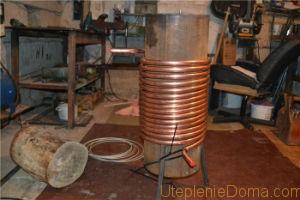
There must be a gap between the turns.
Also, the following values \u200b\u200bare required for the calculation:
- pi;
- the diameter of the pipe that is available (take 10 mm);
- lambda thermal conductivity of metal (for copper 401 W / m * K);
- the delta of the supply and return temperature of the coolant (20 degrees).
To determine the length of the pipe, you need to divide the total thermal power in W by the product of the above factors. Let us consider using the example of a copper heat exchanger with a required thermal power of 3 kW - this is 3000 W.
3000 / 3.14 (Pi) * 401 (thermal conductivity lambda) * 20 (temperature delta) * 0.01 (pipe diameter in meters)
From this calculation, it turns out that you need 11.91 m copper pipe with a diameter of 10 mm so that the heat output of the coil is 3 kW.
How to make a helical coil
After you have made the calculation of the heat exchanger coil, you can proceed directly to manufacturing. The screw structure is quite simple to make. The diameter of the loop must be selected based on the size of the tank in which the installation will be carried out. It is necessary that the pipes do not touch the body.
You need to wind the turns on a round blank. Copper bends easily, so no additional tools are needed. It is advisable to observe a small gap between the turns so that the coolant contacts the pipe from all sides. This will increase the heat exchange area, which will allow us to achieve the maximum heat output that we calculated.
How to make a heat exchanger from straight pipes
To make a coil in a parallel circuit, you need to have the skills of welding metals. For such work, use steel tubes, which are very problematic to bend, although having a good pipe bender is still possible. But in most cases, you have to resort to welding.
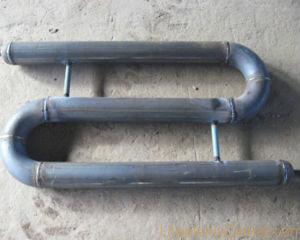
Steel coil made of round pipes.
Work algorithm:
- cut straight lengths of steel pipes;
- lay them parallel on a flat surface;
- connect them with knees with a turn of 180 degrees - if there are no such knees, then you can weld two corners of 90 degrees;
- weld plugs with a branch pipe for connection to the heating system into the lower and upper ends.
In addition, in the lower part, you can install a plug, in the center of which a hole is cut. Then a nut is welded into this hole. Its inner diameter must fit a standard electric heating element. In this case, it will be possible to use a homemade heat exchanger as an electric heater.



